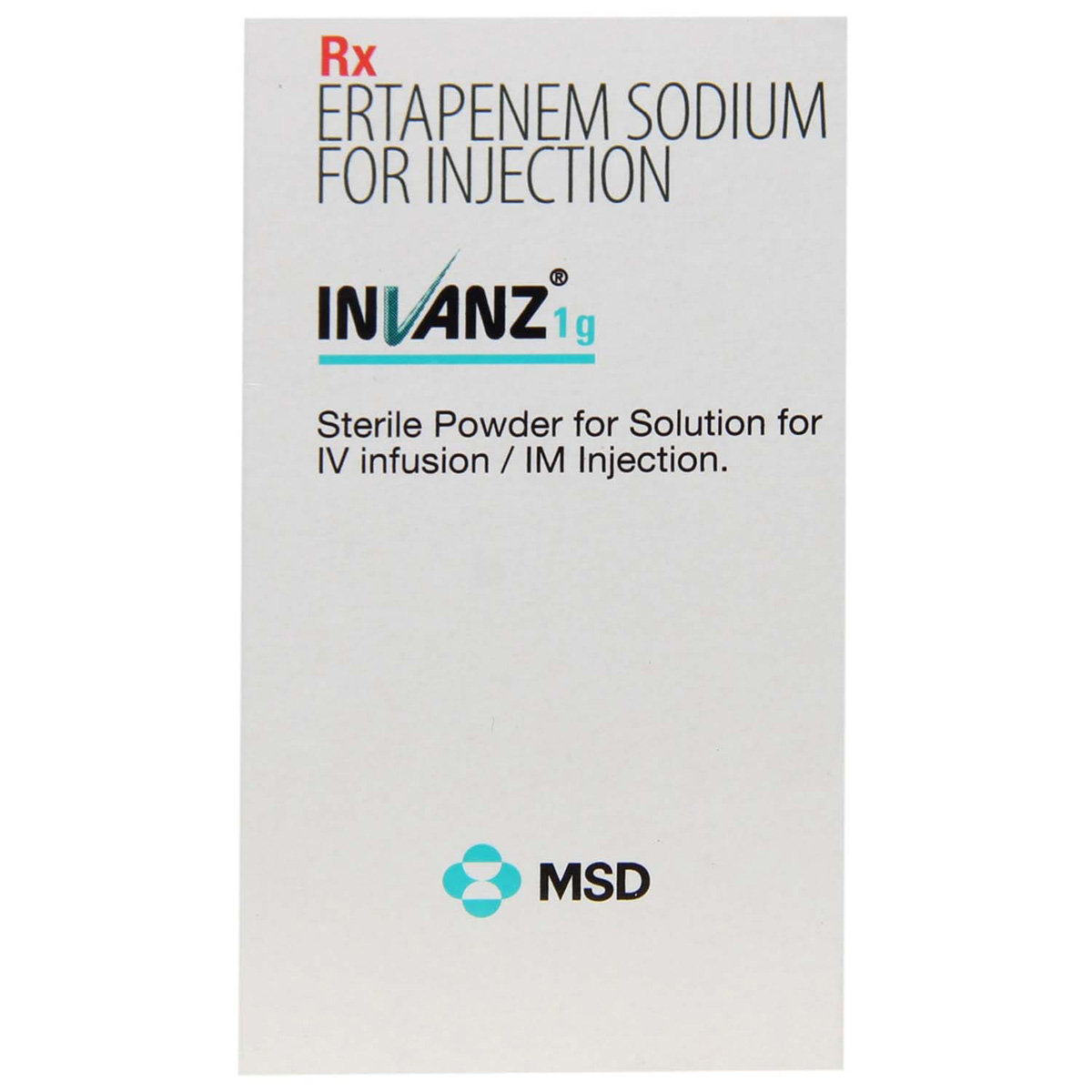Forstal 1 gm Injection 1's
MRP ₹3240
(Inclusive of all Taxes)
₹486.0 Cashback (15%)
Provide Delivery Location
Online payment accepted
 Prescription drug
Prescription drugWhats That
Composition :
Manufacturer/Marketer :
Consume Type :
Expires on or after :
Return Policy :
About Forstal 1 gm Injection
Forstal 1 gm Injection belongs to a class of medications called ‘antibiotics’ used to treat bacterial infections. It can be used to treat intra-abdominal (stomach) infections, skin infections such as diabetic foot infections, community-acquired pneumonia (lung infection), and acute (short-term) gynaecological infections such as urinary tract infections and pelvic infections. It is also used to prevent surgical site infections in patients who have undergone surgery on the colon or rectum.
Forstal 1 gm Injection contains ‘Ertapenem’, which belongs to the class of ‘carbapenem antibiotics. It has bactericidal action and kills the bacteria that are causing the infection. It works by destroying the cell wall (outer layer of the bacteria), which is essential for its survival. Forstal 1 gm Injection does not work against infections caused by viruses.
Forstal 1 gm Injection is available in the form of injection and infusion. You should take this medicine exactly as prescribed by your doctor. The common side-effects of Forstal 1 gm Injection are nausea, vomiting, diarrhoea, headache, and injection site pain. These side effects are usually mild and temporary. However, if these side effects persist or worsen, inform your doctor immediately.
Do not take Forstal 1 gm Injection if you are allergic to ‘Ertapenem’ or antibiotics such as penicillins, cephalosporins, and carbapenems. Before taking Forstal 1 gm Injection, inform your doctor if you have diarrhoea, brain disorders such as seizures (fits), have been taking valproic acid medicine for treating seizures, have kidney failure, and be on a controlled sodium diet. Also, inform your doctor if you are pregnant or breastfeeding. Do not use Forstal 1 gm Injection in children below 2 years of age. In the elderly, dosage adjustments may not be necessary except in patients with kidney failure. Forstal 1 gm Injection may not interact with alcohol. Forstal 1 gm Injection may cause dizziness (less common), so do not drive or operate heavy machinery if you feel dizzy.
Uses of Forstal 1 gm Injection
Directions for Use
Key Benefits
Forstal 1 gm Injection contains ‘Ertapenem’, which belongs to the class of ‘carbapenem antibiotics. It is used in the treatment of high-risk or serious bacterial infections. Ertapenem has bactericidal action and works by killing the bacteria causing the infection. It interferes with the formation of the cell wall, which is essential for the bacteria's survival. It has a broad spectrum of activity and is active against both gram-positive and gram-negative bacteria. It can act against various bacterial strains, such as Enterobacteriaceae (cause infections in healthcare settings), Streptococcus pneumonia (cause community-acquired pneumonia), and anaerobic bacteria, which are common causes of serious infections.
Storage
Drug Warnings
Do not take Forstal 1 gm Injection for prolonged periods as long-term use may cause superinfection (additional infection caused by other microbes). Forstal 1 gm Injection should not be used in patients with diabetic foot infections with ‘osteomyelitis’ (an infection of the bone) as there is no much research regarding the safe use of Forstal 1 gm Injection in these populations. Forstal 1 gm Injection should be used with caution in patients with brain disorders such as seizures (fits) as it may worsen the condition. If you experience diarrhoea before, during, or after the treatment, do not take self-medication without discussing it with your doctor. Diarrhoea may also occur due to the inflammation of the colon. Forstal 1 gm Injection contains sodium, so it should be used with caution in patients on a sodium-restricted diet. Forstal 1 gm Injection may also cause a change in liver function tests, a change in platelet count, and a change in white blood cell count (in children). So, it is essential to monitor these tests if you are taking this medicine frequently.
Diet & Lifestyle Advise
- Eat healthily. Opt for a balanced and nutrient-rich diet.
- Avoid foods rich in calcium, grapefruit, and grapefruit juice, as they might hinder antibiotic absorption.
- Avoid consumption of alcohol to treat your condition effectively.
- Avoid usage of tobacco.
Side Effects of Forstal 1 gm Injection
- Nausea
- Vomiting
- Diarrhoea
- Headache
- Stomach pain
- Injection site pain
Habit Forming
Therapeutic Class
All Substitutes & Brand Comparisons
RX
Out of StockNot for online saleERTAZEN INJECTION 1GM
₹769.3
(₹692.37 per unit)
73% CHEAPERRX
Out of StockNot for online saleErtaneon 1gm Injection
Neon Laboratories Ltd
₹2310
(₹2079.0 per unit)
21% CHEAPERRX
Out of StockNot for online saleErtamac 1gm Injection
Macleods Pharmaceuticals Ltd
₹2400
(₹2160.0 per unit)
18% CHEAPER
FAQs
Drug-Drug Interactions Checker List
- VALPROIC ACID
- PROBENECID
Special Advise
Forstal 1 gm Injection may cause live bacterial vaccines (such as typhoid vaccine) to not work as well. Do not have any immunizations/vaccinations while using this medication unless your doctor tells you to.
Disease/Condition Glossary
Intra-abdominal infections: It is a broader term used to describe infections associated with the stomach, intestine, peritoneum (lining of the abdominal wall), or other parts present in the abdomen. It mostly occurs due to a complication of another condition, such as appendicitis, following surgery, or a trauma. Symptoms depend on the organ affected or the site of infection. Common symptoms include nausea, vomiting, abdominal pain, and change in bowel habits.
Diabetic foot infections: These are major complications of diabetes. In this condition, the skin tissues break down and expose the inner parts of the skin layer. This diabetic foot infection occurs when the diabetes level becomes uncontrollable. It is one of the most common causes of hospitalization among diabetic patients.
Community-acquired pneumonia: It is called community-acquired as this infection is acquired outside the hospital. It is most commonly caused by the bacteria Streptococcus pneumonia. Symptoms include cough, heavy sputum, shortness of breath, fever, and chills. The risk factors are smoking, age above 65 years, alcoholism, and a weak immune system.
Urinary tract infection (UTI): It is an infection in any part of the urinary system- the kidneys, bladder, or urethra. A bladder infection may cause an increased urge to urinate, pelvic pain, pain during urination, and blood in the urine. A kidney infection may cause tenderness and pain in the back, fever, chills, nausea, and vomiting. The causes of UTI include a weak immune system, kidney stones, enlarged prostate, prolonged use of urinary catheters, diabetes, poor bathroom hygiene, sexual activity, and age.
Pelvic infections: It is also called pelvic inflammatory disease (PID). It is a sexually transmitted infection of the female reproductive organs. Symptoms include pelvic pain, fever, and vaginal discharge.

Have a query?
Alcohol
Safe if prescribed
Forstal 1 gm Injection may not interact with alcohol. However, it is advised not to consume alcohol as it may interfere with your ability to fight infections.
Pregnancy
Consult your doctor
Forstal 1 gm Injection is a category B medicine and may not cause harmful effects on the unborn baby. However, your doctor may prescribe this medicine if the benefits outweigh the risks.
Breast Feeding
Consult your doctor
Forstal 1 gm Injection may get secreted in the breast milk. Your doctor may advise you to stop breastfeeding while using this medicine.
Driving
Safe if prescribed
Forstal 1 gm Injection may cause dizziness in some cases. So, do not drive or operate heavy machinery if you feel dizzy.
Liver
Consult your doctor
Forstal 1 gm Injection is probably safe when used in patients with liver diseases. However, if you have liver problems, inform your doctor before taking this medicine.
Kidney
Consult your doctor
Forstal 1 gm Injection should be used with caution if you have kidney problems. Your doctor may adjust the dose if necessary based on your condition.
Children
Safe if prescribed
Forstal 1 gm Injection is not recommended for use in children below 2 years of age. Your doctor will decide the dose of Forstal 1 gm Injection based on your child's age and condition.









